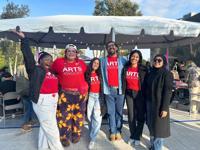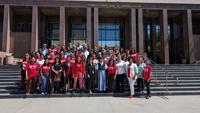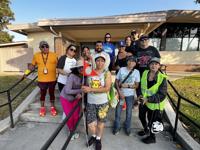
Gustavo Herrera, CEO of Arts for LA. (Photo courtesy of Arts for LA.)
California was about to be in 45th place for per capita funding for the arts after Governor Gavin Newsom’s May Revision proposed budget cuts.
That’s when Arts for LA, the region’s only cross-discipline arts advocacy organization, went to work and effectively defended the arts against 75% of the budget cuts.
In July, the Los Angeles Department of Arts and Culture announced over $6.4 million in grants to 318 arts, cultural, social justice, and social service nonprofit organizations.
“The county invested an additional $1.2 million on top of their budget because they understand the value of arts and culture,” Gustavo Herrera, CEO of Arts for LA, told CALÓ News. “They see this as a moment to not reduce, but to invest more.”
Arts for LA builds and contributes to coalitions actively protecting and promoting creative career pathways while leading communities, artists and organizations to advocate for an equitable, healthy and vibrant city through the arts.
Before leading Arts for LA in 2018 and entering the field in the early 2000s, Herrera remembers growing up in Silver Lake in Section 8 Housing alongside his creative Salvadorian parents.
“Creativity was very much and is very much alive in my household,” Herrera said. “I have many memories of [my father] painting and doing creative things in our household. He restocked vending machines and was a janitor. My mom was a lifelong babysitter, but they always seemed to be working on creative projects. I knew early on that I wanted to work in the arts and culture field.”

Arts for LA staff pose with members of Arts for LA's ACTIVATE Emerging Arts Leaders at an art activation they created and hosted during Music Center LA's "On the Record" vinyl fair on May 4, 2024. (Photo courtesy of Arts for LA.)
Realizing at age 16 that he wanted to become a museum director, Herrera pursued this passion at the University of California, Santa Barbara, where he earned his bachelor’s degree in global studies with an emphasis in sociopolitics, economics and art history in 2006. He received a master of business administration from American Jewish University. He entered the art industry as an exhibitions administrator at the Los Angeles County Museum of Art, where he worked until 2010.
His following experiences include positions at the Maestro Foundation, a classical music and performing arts foundation, LA Plaza de Cultura y Artes and directing the West Coast division of Young Invincibles, advancing policy priorities on health care, higher education, jobs and civic engagement.
“While working at Young Invincibles, I focused on statewide and national policy and fell in love with creating change at a systemic level,” Herrera said. “With Arts for LA, I saw it as a unique opportunity to connect my love for museums and our arts and culture with systemic change.”
Herrera is thankful for his mentors throughout his career within the arts and culture world. “That's something I think about a lot today because part of what's so challenging about the arts and culture field is it's about who you know,” he said “Arts for LA spends a lot of time building community, building entry points into arts and culture and building networks.”
As Latinos, finding those who share your experiences is just as important as building networks, if not more so, according to Herrera. “It's about having a network of individuals who look like us,” he said. “In arts and culture, that's one of the biggest challenges we face: diversity. It's not as diverse of a field as it can be, so even when you find yourself in the industry, it's also making connections with people who share similar experiences.”
CALÓ News spoke with Herrera to discuss Arts for LA, supporting the Latino community through the arts and the 2028 Olympics.
The answers have been edited for brevity and clarity
You are the chief executive officer of Arts for LA as of 2018. Can you talk a bit about the origins of the organization and its mission?
Arts for LA was founded in 2005. Next year, we will be celebrating our 20th anniversary. The organization was founded because there was a moment in time in 2005 when the city of L.A., L.A. County, the state of California and the L.A. Unified School District, all of those agencies were going to cut the budget for the arts all at once. Leaders of the arts and culture field at the time, such as the L.A. Philharmonic, came together and said, ‘We need to fight against these cuts and we need a concerted voice. It cannot just be one organization going to the city council or the state. We need to do this as a collective.’ That was the birth of Arts for LA. We were created in a moment of crisis. These organizations had representatives who ultimately formed the board of directors of Arts for LA in 2005 and then went on to fight these budget cuts. Fast forward to today, even this year, we're still fighting those budget cuts.
What sort of programs does Arts for LA have and how can individuals get involved?
Firstly, the State of the Arts Summit is our big convening for the arts and culture field. It brings together about 350 people and it will be at the Ebell of Los Angeles this year. We will also talk about the legacy of the Creative Jobs Collective Impact Initiative (CJCII). The CJCII is our signature initiative at Arts for LA. The goal is to pathway 10,000 youth and adults from historically underrepresented communities into the creative economy by the year 2030.

Performer Jo Lopez and DJ Miss Ninja entertain attendees during the 2023 Arts for LA Summit. (Photo courtesy of Arts for LA.)
Every year, we commission one research project and select one researcher to study a topic [for the Laura Zucker Fellowship]. This year, we selected Lindsay Kunisaki and she is our 2024 Laura Zucker fellow for policy and research and she is diving deep into the implementation of Proposition 28 [2022’s Arts and Music Education initiative].
Our Activate program is our leadership development program. It's built specifically for creative workers and we train individuals on how to be advocates out in the field, such as community organizing. We have different tracks for Activate that include the Emerging Arts Leaders track, a Protege track and there’s even a high school student organizing track.
Then, we have Arts Month, which usually happens in April. During Arts Month, we connect the community of Arts for LA to elected officials.
Finally, we have our Evening Webinar Series for Arts Workers. One time per year, over five months, folks will post online gatherings for the cultural worker community.
How and why should someone become a member of Arts for LA?
There are many ways to get involved, one of them being to become a part of the new Activate cohort which will be recruiting people to join in the late fall and will begin in February of next year. If anyone is interested in becoming a part of our Activate program, that's a great way to engage with the organization. You can sign up for our monthly newsletters to see what's happening with the organization. If you become a part of our newsletter, you'll see what we have lined up every month that you can participate in, whether it's attending an event or participating in one of our workshops, training or community listening sessions.
You can also become a member of the organization as an individual member of Arts for LA, which has levels starting at $35. If you are a leader of an organization, or you represent an organization, your organization can become an organizational member of Arts for LA.

The Effective & Healthy Partnerships panel at the 2023 State of the Arts Summit. (Photo courtesy of Arts for LA.)
As the region’s only unified voice for the arts, why is Arts for LA such an important resource and tool for the L.A. community and its people?
We are cross-disciplined and cross-sectored, meaning that our job is to connect folks who are working in the performing arts field to people who are working in entertainment, museums and theater. We create one community across all of the disciplines of the arts and we do not limit that to nonprofits. We make sure that we're connecting nonprofit folks with government folks, with folks who are in the industry, in the business and corporate world. That's unique in the field because there are a lot of organizations that are very focused on one specific discipline or one specific sector, but not one that's bringing everyone together. That’s what makes us unique.
Do you hope it sets a precedent for other nonprofit organizations to be created for the arts?
Yes, and we're already starting to see some of this. There's a great organization in San Diego called the San Diego Regional Arts Coalition and one in the San Bernardino area called Arts Connection. We're seeing a lot more of these regional advocacy or art service organizations building out and they’ll often reach out to us seeking to learn a little bit from our experiences. We're always happy to share what our successes have been, but also where we have fallen. We have fallen hard at times so that other folks don't make the same mistakes. We also have, at the regional level, a wonderful state advocacy organization called California for the Arts that is doing great work at the state level, as well as Americans for the Arts, which does federal and national advocacy work. We partner with both California for the Arts and Americans for the Arts on statewide and federal advocacy and we go to them seeking counsel and advice too because we're learning from each other.

Arts for LA staff and arts advocates pose for a group picture outside the LA County Board of Supervisors meeting during Arts Day on April 8, 2024. (Photo courtesy of Arts for LA.)
Arts for LA has a few Advocacy Areas meant to build a creative and thriving infrastructure. What are these areas and what work is being done to accomplish their visions?
We're working on four issue areas—jobs, education, space and funding. Equitable arts education is making sure that arts education in the classrooms is offered equitably across the county. [In terms of jobs,] that is the CJCII, which is trying to build a more diverse and sustainable workforce by making it more representative. Space is about addressing both housing affordability that is impacting our artists and creative workers, as well as workspace affordability. Arts and culture workers need workspace access, which isn’t affordable in Los Angeles. We fight for that.
With the majority of LA’s population being Latino, how does Arts for LA plan to support/cater to this community?
This is something that I think about a lot because Hispanic, Latino, Latinx and Latine arts and cultural workers are 13% of the creative workforce in LA. When you look at all arts and cultural workers in LA, 13% of them are Latino, but we know that 49% of the county is Latino or Latina. Latinos have the biggest gap to close in arts and culture, so that's the first thing that we're trying to address through the CJCII. When we're building out the 10,000 job placements, we need to ensure that our Latine communities and our Black communities are finding pathways into the creative economy so that we can build a more diverse workforce from the various diversity measures.
There was a study that was done by the LA County Department of Arts and Culture that looked at wages for creative workers, specifically entry-level wages for creative workers and Latino communities were the lowest of all of the average earnings in creative workers. When we look at the CJCII, that effort is trying to increase diversity representation, but it's also trying to increase wages. We believe that the CJCII, especially because Latine communities are the least represented from a demographic creative workforce and the lowest paid, an initiative that's focused on building more diversity and increasing wages, is going to lift the Latino community in the process, and we've been intentional about messaging that too.
What does the future look like for Arts for LA? Is there anything new on the horizon?
What's exciting and on the horizon for us is the LA 2028 Olympic and Paralympic Games, because that is a huge organizing moment for the arts and culture field to collaborate and to work together. It is also a huge opportunity to showcase local artists on a global scale. Arts for LA is already a part of LA 28, the entity that is organizing the 2028 Olympic and Paralympic Games, and their local hire working groups. We’re a part of those conversations trying to make sure that artists and arts organizations are at the center of these conversations. Ultimately, the field will need to be coordinated and organized and Arts for LA intends to play a central role in helping accomplish that.
Arts for LA’s State of the Arts Summit will take place at the Ebell of Los Angeles on Wednesday, October 16. Tickets are available for purchase here.



















(0) comments
Welcome to the discussion.
Log In
Keep it Clean. Please avoid obscene, vulgar, lewd, racist or sexually-oriented language.
PLEASE TURN OFF YOUR CAPS LOCK.
Don't Threaten. Threats of harming another person will not be tolerated.
Be Truthful. Don't knowingly lie about anyone or anything.
Be Nice. No racism, sexism or any sort of -ism that is degrading to another person.
Be Proactive. Use the 'Report' link on each comment to let us know of abusive posts.
Share with Us. We'd love to hear eyewitness accounts, the history behind an article.